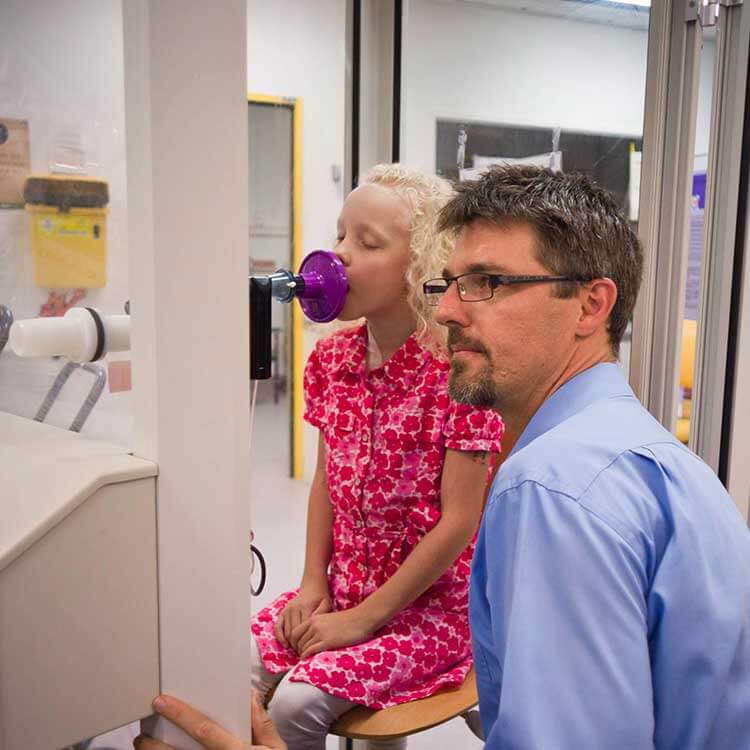Search

News & Events
Lung problems continue into childhood for premmie babiesNew research from Perth’s The Kids Research Institute Australia shows that babies born premature continue to have lung problems well into childhood.
Research
Increased exhaled nitric oxide in wind and brass musiciansPlaying a wind or brass (W/B) instrument is considered a strenuous activity for the respiratory system.
We’ve heard from families that trustworthy information about preterm-associated lung disease is difficult to find. In response, we’ve created resources to empower families with the knowledge they need to manage these challenges.
Research
Associations of early-life pet ownership with asthma and allergic sensitization: A meta-analysis of more than 77,000 children from the EU Child Cohort NetworkStudies examining associations of early-life cat and dog ownership with childhood asthma have reported inconsistent results. Several factors could explain these inconsistencies, including type of pet, timing, and degree of exposure. Our aim was to study associations of early-life cat and dog ownership with asthma in school-aged children, including the role of type (cat vs dog), timing (never, prenatal, or early childhood), and degree of ownership (number of pets owned), and the role of allergic sensitization.
Research
The PELICAN (Prematurity's Effect on the Lungs In Children and Adults Network) ERS Clinical Research Collaboration: understanding the impact of preterm birth on lung health throughout lifeAn estimated 15 million babies (∼11%) are born preterm each year (before 37 weeks of gestation), the rates of which are increasing worldwide. Enhanced perinatal care, including antenatal corticosteroids, postnatal surfactant and improved respiratory management, have markedly improved survival outcomes since the 1990s, particularly for babies born very preterm (<32 weeks gestation). However, long-term pulmonary sequelae are frequent in preterm survivors and ongoing clinical management is often required.
Research
Does machine learning have a role in the prediction of asthma in children?Asthma is the most common chronic lung disease in childhood. There has been a significant worldwide effort to develop tools/methods to identify children's risk for asthma as early as possible for preventative and early management strategies. Unfortunately, most childhood asthma prediction tools using conventional statistical models have modest accuracy, sensitivity, and positive predictive value.
Research
Variants associated with HHIP expression have sexdifferential effects on lung functionLung function is highly heritable and differs between the sexes throughout life. However, little is known about sexdifferential genetic effects on lung function. We aimed to conduct the first genome-wide genotype-by-sex interaction study on lung function to identify genetic effects that differ between males and females.
Research
Pulmonary Gas Exchange Improves over the First Year in Preterm Infants with and without Bronchopulmonary DysplasiaRight shift of the peripheral oxyhaemoglobin saturation (SpO2) versus inspired oxygen pressure (PIO2) curve is a sensitive marker of pulmonary gas exchange. The aim of this study was to assess the impact of prematurity and bronchopulmonary dysplasia (BPD) on gas exchange and right-to-left shunt in the neonatal period, and its evolution over the first year of life.
Research
Profile of the PLAY spaces & environments for children’s physical activity, sedentary behaviour and sleep (PLAYCE) cohort study, Western AustraliaChildhood is a critical period for the development of movement behaviours such as physical activity, sleep and sedentary behaviour. The PLAYCE Cohort was established to investigate how movement behaviours change over early to middle childhood, across key behaviour settings and relationships with health and development. An overview of the PLAYCE cohort, summary of key findings to date, and future research opportunities are presented.
Research
Surgical pleth index: Prediction of postoperative pain in children?It was the aim of this study to define a clinically appropriate SPI target to predict moderate-severe postoperative pain in children.
